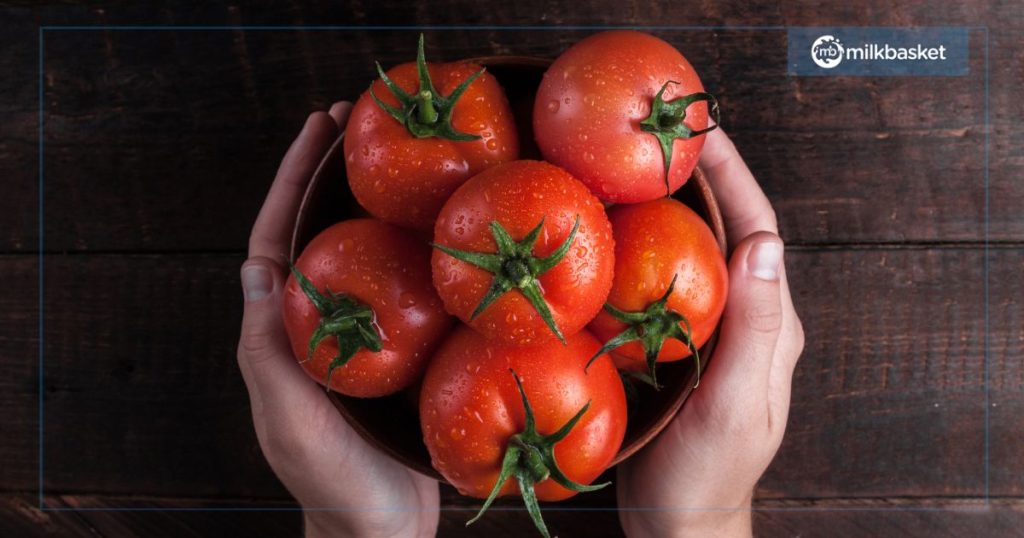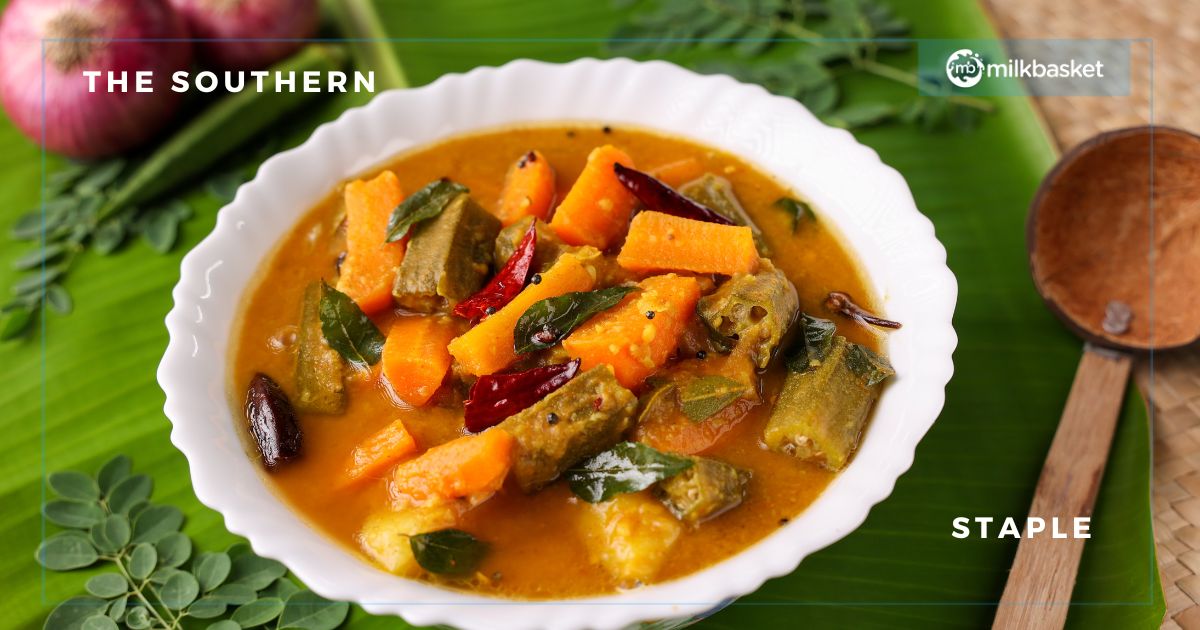A Versatile And Delicious Sambar For Every Mood
Sambhar or sambar is a Southern Indian dish which comprises of lentils, vegetables and spices. It is described by late food historian KT Acharya as “a fairly thick spicy extract of thuvar dhal soured with tamarind, frequently containing soft vegetables like brinjal, gourd and lady’s finger” A sambar is a great accompaniment for hot idlis, dosa, vadas or white fluffy rice. It is nutritious, wholesome and filling. Tamarind is full of pectin which helps the sambar become thicker and richer. The vegetables added to sambar give it more colour and flavour.
There are many types of sambar. We shall focus on the all encompassing, ever tasty sambar and of course the sambar powder to help you make a delicious sambar with any and all vegetables you have at hand.
Traditionally sambar is made with Tur dal (arhar dal or pigeon pea lentils) but it can also be made with moong (yellow mung lentils) or masoor dal (orange lentils) or a mixture of all. You can choose the ratio of the dals as per your liking.
PREPARATION FOR SAMBAR

- Tamarind is a key ingredient for sambar and the best way to have it is to soak 1 tablespoon of it in ⅓ cup of hot water for 20-30 minutes.
- Once soaked and down to room temperature, squeeze the tamarind and discard the pulp.
- Rinse ½ cup (100 grams) tuvar dal till the water is clean or less cloudy. Use unpolished tuvar dal for better nutrition. You can even soak the dal an hour prior to cooking for better results.
- Drain all the water from the dal and put it in a 2 litre cooker with ¼ teaspoon turmeric powder. Add 1.5 to 1.75 cups of water.
- Alternatively, you can cook it in an open pan or an instant pot. Add water accordingly.
- Cook the dal for 7-9 whistles or 9-10 minutes on a medium flame.
- Once the pressure of the cooker has settled naturally, open the lid and mix the dal with a whisk or a spoon. Mash it and make it smooth. Keep it aside

COOK THE VEGETABLES


- While the dal is pressure cooking, peel, cut and chop the vegetables you would like to put in the sambar. Ideally cut the fast cooking vegetables in large pieces, namely pumpkin, aubergines, okra, onions, drumsticks etc. And the vegetables which take longer to cook, namely potatoes, carrots, beans , are cut in a smaller size so that all the vegetables are cooked evenly and at the same time.
Tip: Cut the brinjals/aubergines just before cooking otherwise they blacken.
- Take 1-1.5 cups of vegetables and place them in a pot along with 7-10 pearls of medium onions or 1 small onion (thick sliced) best are the sambar onions put in whole. Add 1 medium or small tomato quartered.
- Add ¼ spoon turmeric and kashmir red chilli powder. Add enough water to cover the vegetables and stir. Cook on a medium-low to medium flame. Stirring and checking occasionally to see the vegetables are cooked.
- Ensure the vegetables are cooked and NOT over cooked.
MAKING THE SAMBAR

- Add the tamarind pulp to the cooked vegetables or if you do not have fresh tamarind you can use packet tamarind paste. Use ½-1 tablespoon of the packet tamarind paste and mix well.
- Add the sambar powder (recipe below). Add 1-1.5 tablespoons or as per your taste. You can also add ½-1 teaspoon of jaggery powder, this is optional.
- Stir well and add the dal.
- Mix the dal and vegetables and if you feel the mixture is thick, you can add some water to make it thinner. But too much water is not advisable because they can dilute the flavours.
- Simmer the mixture on medium-low heat and stir occasionally and once it starts boiling and creating a frothy layer on the top, turn off the heat.
TEMPERING THE SAMBAR

- Take 2 tablespoons gingely oil (raw sesame seed oil) alternatively you can use ghee, sunflower or coconut oil as well. Heat in a tadka pan or a pan.
- Add ½ teaspoon mustard seeds, let it crackle on low heat.
- Add 1-2 deseeded dried red chillies and immediately add 10-12 curry leaves, 5-6 methi seeds and 2 pinches of hing. If you are gluten free you can skip the hing or add gluten free hing.
- Fry this till the red chillies change colour and the curry leaves crisp up, on low heat and ensuring that the spices don’t burn.
- Add the tempering to the sambar and immediately cover it for 4-5 minutes so the aroma and the taste is absorbed by the sambar.
- Serve hot with coriander as a garnish.
SAMBAR POWDER

To make 500 grams of sambar powder
Ingredients
- 1.25 cups coriander seeds – 40 grams
- 5 tablespoons cumin seeds
- 40 to 45 dry red chillies – halved and deseeded
- 3.75 teaspoon methi seeds
- 2.5 tablespoon black peppercorns
- 5 tablespoons chana dal
- 2.5 tablespoon urad dal
- 0.83 curry leaves
- 1.25 tablespoon mustard seeds
- 1.25 hing
- 1.25 tablespoon turmeric powder
Method
- Heat a frying pan and add coriander and cumin seeds.
- On low heat, roast the seeds for 1-2 minutes until brown and fragrant. Do not burn them.
- Remove the seeds on a large plate and wipe the pan with a paper towel. Add the dry red chillies,halved, deseeded and crowns removed.
- Roast the chillies until they change colour, develop a smoky flavour and pungent. Remove and place them on the same plate.
- Add methi seeds, brown them and remove on the same plate.
- Add black peppercorns, roast and make aromatic. Once done, add to the same plate.
- Add chana dal and brown/have a golden colour to them. Since it takes longer and you want an even roast, stir them constantly. Once done add to the plate.
- Add urad dal, roast till brown or golden and aromatic. Remove on the plate.
- Add curry leaves (dried or fresh) and roast them till they are crisp. Remove and keep on the plate.
- Add mustard seeds and let all of them pop. Remove on the plate once all of them are done.
- Switch off the flame and add the hing in the pan. Quickly stir and let the hing become aromatic and change colour. Remove immediately and put on the plate.
- Once the spices have cooled down, grind it in a grinding jar and add turmeric powder.
- If you want you can do it in batches, but make sure you thoroughly mix all the powder once removed from the jar.
- Before storing in an airtight jar, cool down the sambar powder because it will be warm from the grinding process.
Categories
Popular Posts
-

Milkbasket – A Revolution In The Online Grocery Delivery Services In India
Spread the loveThere’s no denying the fact that the pandemic has drastically changed the way people spend their time online, buying everything through various online retail platforms with the convenience of home deliveries in India. Milkbasket, with it’s features has proven to be a revolution in the online grocery delivery services in India. While stepping […]
08 Jul 2022 read More... -

Milkbasket’s Latest DVC Campaign Is Out, And It’s Quirky And Relatable As Heck!
Spread the loveThe year 2021 was all about patience, resilience, and the grind it takes to get back up from a worldwide slump that the COVID-19 pandemic had hit us with. It made us all revisit our roots, recalibrate our priorities, and strengthen our foundations. With the better part of 2022 gone into slowly spreading […]
28 Sep 2022 read More... -

Nabhi Chikitsa or Belly Button Therapy: The Simple Health Secret You NEED To Know!
Spread the loveOur Navel or Belly Button (scientific name Umbilicus) is believed to be the centre of our life force. Most of us take it as just another part of our body not knowing its deep, thrilling world. In ancient Hindu healing practices, the Navel is considered to be the most important point of the […]
08 Sep 2022 read More... -

Recycling At Milkbasket: A World Environment Day Special
Spread the loveAs people who serve and bring convenience to other people, it’s important for us as brands to give a thought from time to time to what matters the most to us as human beings. The realization of the countless resources that our planet has provided us allows us to be amazed and humbled […]
05 Jun 2022 read More...

